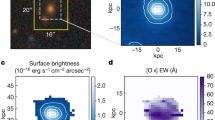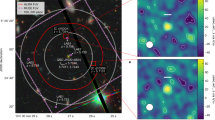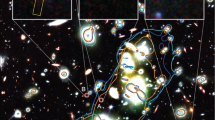Abstract
SEVERAL nearby E and SO galaxies are known to contain weak (Lrad∼1039erg s−1) radio sources1–3. Heeschen4 found that these sources fall into two distinct classes: ‘extended’ sources with steep radio spectra and sizes comparable to their parent galaxies, and ‘compact’ sources with flat spectra, which are centred on the optical nucleus and have sizes smaller than a few arc s. Although ionised gas is generally inconspicuous in E/SO galaxies, spectroscopy of ∼24 E/SO radio sources3,5,6 suggests a high incidence of optical emission lines in galaxies with compact radio structure. The two best-known examples, NGC1052 and NGC4278, have, in addition to unusually strong emission lines, abnormal amounts of neutral hydrogen7–9, and this has led to the speculation10 that radio outbursts in early type galaxies are fuelled by accretion of neutral gas, possibly from intergalactic clouds. As part of an optical study of E/SO sources with flux densities higher than 20 mJy from the deep Arecibo radio survey of Dressel and Condon11, we have recently obtained spectrophotometry of 57 objects which makes the radio structure–optical line emission correlation more definitive. The 2,380 MHz Arecibo survey of bright Uppsala General Catalogue galaxies included 2,095 objects with 0°≤δ≤+37°. 24% of the E, and 12% of the SO galaxies were detected at the 5σ level (S2380>15 mJy). Interferometer observations12 of the brighter sources allowed separation into the compact (CRS) or extended (ERS) categories; continuing work with higher resolution indicates that several ERS objects have a well-defined double structure (J. J. Condon, personal communication). The optical observations were made with the image dissector scanner on the Kitt Peak National Observatory 2.1 m telescope in December 1977. The scanner was operated with an 8.4-arc s diameter entrance aperture, which yielded an effective resolution of ∼ 11 Å. Scans covered λλ 3400–5200. We confine our attention here to [O II] λ 3727, which is expected to be ∼ 10 times stronger against the galaxy background in objects with spectra like NGC1052 (ref. 8) than is Hβ.
This is a preview of subscription content, access via your institution
Access options
Subscribe to this journal
Receive 51 print issues and online access
$199.00 per year
only $3.90 per issue
Buy this article
- Purchase on Springer Link
- Instant access to full article PDF
Prices may be subject to local taxes which are calculated during checkout
Similar content being viewed by others
References
Rogstad, D. H. & Ekers, R. D. Astrophys. J. 157, 481–494 (1969).
Heeschen, D. S. Astr. J. 75, 523–529 (1970).
Ekers, R. D. & Ekers, J. A. Astr. Astrophys. 24, 247–253 (1973).
Heeschen, D. S. Astrophys. Lett. 6, 49–53 (1970).
Disney, M. J. & Cromwell, R. H. Astrophys. J. Lett. 164, L35–L39 (1971).
Colla, G. et al. Astr. Astrophys. 38, 209–223 (1975).
Knapp, G. R., Kerr, F. J. & Williams, B. A. Astrophys. J. 222, 800–814 (1978).
Fosbury, R. A. E., Mebold, U., Goss, W. M. & Dopita, M. A. Mon. Not. R. astr. Soc. 183, 549–568 (1978).
Knapp, G. R., Gallagher, J. S. & Faber, S. M. Astr. J. 83, 139–146 (1978).
Gunn, J. E. Phys. Scripta 17, 277–280 (1978).
Dressel, L. L. & Condon, J. J. Astrophy. J. Suppl. 36, 53–75 (1978).
Condon, J. J. & Dressel, L. L. Astrophys. J. 221, 456–467 (1978).
Humason, M. L., Mayall, N. U. & Sandage, A. R. Astr. J. 61, 97–162 (1956).
De Vaucouleurs, G., de Vaucouleurs, A. & Corwin, H. G. Second Reference Catalogue of Bright Galaxies (University of Texas Press, Austin, 1976).
Adams, T. F. Astrophys. J. Suppl. 33, 19–37 (1977).
Haynes, J. P., Brown, R. L. & Roberts, M. S. Astrophys. J. 221, 414–421 (1978).
Lo, K. Y. & Sargent, W. L. W. Astrophys. J. (in the press).
Mathews, W. G. & Bregman, J. N. Astrophys. J. 224, 308–319 (1978).
Blandford, R. D. & Rees, M. J. Phys. Scripta 17, 265–274 (1978).
Author information
Authors and Affiliations
Rights and permissions
About this article
Cite this article
O'CONNELL, R., DRESSEL, L. Incidence of ionized gas in E/SO radio galaxies. Nature 276, 374–375 (1978). https://doi.org/10.1038/276374a0
Received:
Accepted:
Issue Date:
DOI: https://doi.org/10.1038/276374a0
Comments
By submitting a comment you agree to abide by our Terms and Community Guidelines. If you find something abusive or that does not comply with our terms or guidelines please flag it as inappropriate.



